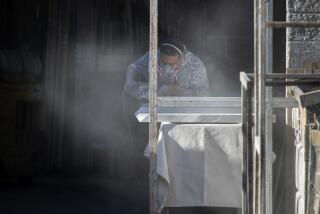Solis Seeks Better Monitoring of Pollution From Gravel Pits
- Share via
State and federal regulators have failed to adequately monitor the environmental consequences of massive gravel mining that has carved canyon-sized holes in the San Gabriel Valley, Rep. Hilda L. Solis (D-El Monte) charged Friday.
Gravel mining has taken place in the Irwindale area for more than 100 years, supplying the sand and rock for more than 70% of California’s roads and much of the building material for Los Angeles’ sprawling real estate development.
Yet the U.S. Environmental Protection Agency and state air quality officials appear to lack even the most basic information needed to assess the mines’ contributions to air and water pollution in the surrounding area, now home to more than a quarter-million people, Solis said.
She based her statements on the findings of a congressional report commissioned by her and another California Democrat, Rep. Henry Waxman of Los Angeles, that found a lack of environmental oversight of the gravel pits.
San Gabriel Valley residents suffer higher rates of asthma and other respiratory ailments than others in the region, a situation Solis and some local politicians suspect is linked to dust and particle pollution from mining.
Residents of Irwindale, Baldwin Park, Azusa and El Monte “should be able to get a better quality of life, and they should get better information” on the health risks of the gravel pits, Solis said, standing outside Geddes Elementary School in Baldwin Park.
Responding to Solis’ concerns, officials with the South Coast Air Quality Management District announced Friday that they would begin to monitor specific mining operations in the area.
But they noted that they had regulated the operations for years and have a general air monitoring station in Azusa within a mile of most of the gravel pits. This year, that monitor found 22 violations of the state’s standard for particulate pollution, said Chung Liu, the AQMD’s deputy executive officer for science and technology advancement.
Arnold Brink, a general manager with United Rock Products, which runs one of Irwindale’s 17 gravel pits, said the firm would cooperate with regulators. But it is hardly lacking for oversight, he said, noting that, he once counted 26 different governmental entities at the local, state and federal level that were reviewing its mining practices.
“I honestly think we do a good job and are good stewards of the environment,” Brink said. “If you sat at my desk and saw things from my perspective, I don’t think you could say we are under-regulated.”
Solis and others at the news conference, including a woman whose husband suffered from asthma and whose father had worked in a local quarry, emphasized that they valued the economic benefits the mines had brought. But they added that the health effects to which the operations might be contributing needed a closer examination.
“The residents in this area are absolutely right to be concerned,” said Constantinos Sioutas, a professor and deputy director of the Southern California Particle Center at USC.
Particles in the lungs that are stirred up by gravel mining “stay much longer than gases” and have been linked to higher mortality rates, he said.
More to Read
Get the L.A. Times Politics newsletter
Deeply reported insights into legislation, politics and policy from Sacramento, Washington and beyond. In your inbox three times per week.
You may occasionally receive promotional content from the Los Angeles Times.










